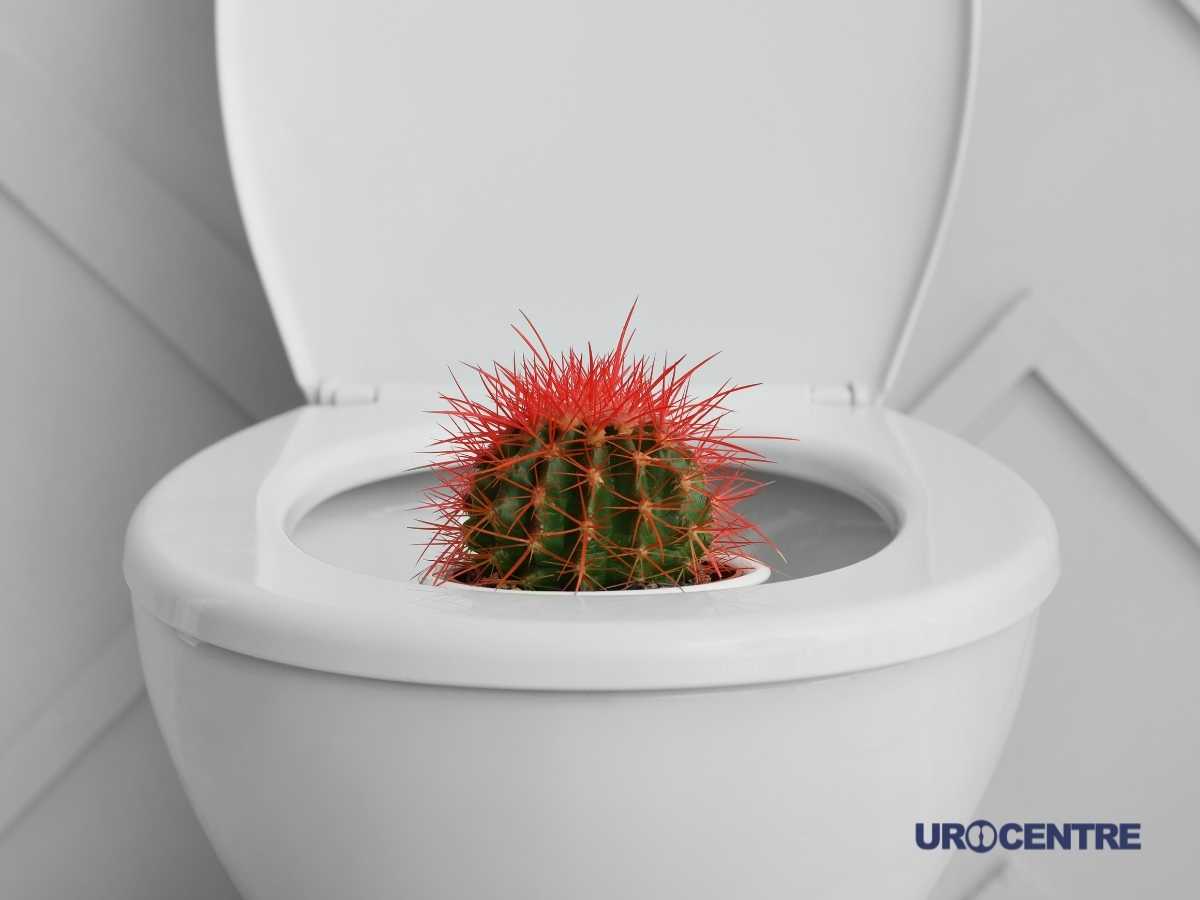Piles or hemorrhoids are swollen and painful groups of blood vessels and tissues in the lower anus or rectum. This is the most common problem with the ovaries. Piles can form under the skin around the anus or in the rectum. In Hindi, piles are also called Bawaseer.
Pile formation can happen inside or outside of the rectum. Where the swollen vein starts determines what kind of pile it is. Some examples are:
External Piles: Around the anus, small bumps form under the skin. They are very painful and scratchy. Most of the time, there is bleeding. In some cases, they can fill up with blood, which can lead to clots that can make pain and swelling worse.
Internal Piles: These are lumps that form in the rectum and are usually not visible on an outside exam. Small amounts of blood can be seen when going to the bathroom. They rarely hurt or make you feel bad.
Internal and external piles can both prolapse, which means that they stretch and bulge outside the anus. These could bleed or hurt a lot.
Signs and Symptoms of piles
Most of the time, piles symptoms aren’t serious and go away on their own. But piles can be identified by one or more of the following:
Irritating bumps around the anal area
Itchiness, redness, swelling, and pain.
Fluid near the anus that looks slimy
Bright red blood after going to the bathroom
Even after passing stool, you feel like your bowels aren’t clear.
What causes Piles ?
It’s not clear what causes piles, but they are linked to higher pressure in the blood vessels and tissues around the anal area, which causes swelling and inflammation. The condition can happen when there is too much pressure in the lower rectum.
- Having a hard time going to the bathroom
- Sitting on the toilet for a long time
- Having diarrhea or constipation for a long time
- Ageing
- Being obese
- Being sexually active and pregnant
- Having a diet with few fibers
- Often lifting heavy things
Factors of Risk
Even though piles can happen to anyone, no one knows how it happens. Here are some of the possible risk factors for piles that could make a person more likely to get the disease:
- Being obese or overweight
- Lesser fibre intake
- Pregnancy
- Constipation or diarrhea that doesn’t go away
- Do things that make you work harder, like lifting heavy things.
- Sitting around all day
- Have a history of piles in your family
- Between 45 and 65 years old (can occur in all age groups; however, it is more common during this period)
Preventing Piles
There may not be a surefire way to avoid getting piles. Still, there are ways to lower the chance of getting piles or making them worse. Some ways to keep piles from happening are listed below:
- Don’t spend too much time on the toilet.
- Work with your doctor to deal with constipation and avoid straining.
- Keeping your weight at a healthy level
- Eating healthy foods
- Not lifting heavy things
- Keeping physically fit by working out regularly
How are Piles Diagnosed ?
Most of the time, the primary care doctor will be able to tell if you have piles based on your symptoms and a physical exam. The doctor will carefully look at the anal area as part of a full physical exam. The doctor might ask you the following:
Does anyone you’re close to have piles?
Have the stools had any blood or mucus in them?
Has anyone lost weight recently?
Have you had different bowel movements lately?
But in some cases, the following tests may also be suggested to confirm that piles are present and how bad they are.
Digital Rectal Exam: The doctor will put a gloved, lubricated finger into the rectum to feel for swollen blood vessels.
Anoscopy: The doctor will look at the lining of the anus and rectum with a lighted tube called an anoscope.
Sigmoidoscopy: The doctor will look at the lower part of the colon and rectum with a lighted tube with a camera called a sigmoidoscope. There are two kinds of this technique: flexible and rigid sigmoidoscopy.
Stool Guaiac Test: A sample of poop is looked at to see if there are any signs of blood in it.
Colonoscopy: The doctor may use a colonoscope, which is a long, flexible, lighted tube, to look at the whole colon for any abnormal growths, red or swollen tissue, sores, or bleeding.
Image: Tests to see if you have piles
How to get ready for a visit to the doctor?
Write down all of the symptoms, even ones that seem to have nothing to do with the illness.
The patient must tell the doctor about important things about themselves, like what they eat and how often they go to the bathroom.
The patient must tell the doctor about any medications, vitamins, or supplements he or she is taking.
The doctor should be asked the following:
What’s the most likely reason for the problem?
Is this likely to be a short-term or long-term problem?
Will this condition lead to any other problems?
What kind of treatment do you suggest?
If the first set of treatments doesn’t work, which treatment would?
Should I go in for surgery? What’s the deal?
Are there other ways to take care of yourself that might help?
I have other health issues. How do I deal with these as well as my hemorrhoids?
Treatment for Piles
Most of the time, piles get better on their own without any treatment. But if someone has piles for a long time, the lumps may get bigger and the symptoms may get worse, which can cause a lot of pain, discomfort, and a lower quality of life. In that case, the proctologist may recommend one of the following ways to treat piles:
How to Get Rid of Piles at Home
People with piles can often get rid of the pain, swelling, and inflammation at home by doing the following:
- By using an ice pack or taking a hot bath (also called a sitz bath).
- Make sure that the area around your anus is clean and dry.
Medications:
Depending on how bad the hemorrhoids are, the proctologist might recommend:
Pain relievers like acetaminophen, aspirin, and ibuprofen can help temporarily ease the pain.
Stool softeners would help with the problem of being unable to go to the bathroom.
You can buy hemorrhoid creams or suppositories with hydrocortisone over-the-counter, or you can use pads with witch hazel or a numbing agent.
Ayurvedic ways to treat piles
Vijaya Churna and Pathyadi Kwatha are two ayurvedic medicines that can be used to treat hemorrhoids.
Getting rid of piles without surgery
If haemorrhoids don’t get better with home remedies and prescription drugs, you can try the following non-surgical piles treatments:
Rubber band ligation: In this procedure, the surgeon wraps a rubber band around the hemorrhoids. This causes the hemorrhoids’ tissues to die, which makes them fall off.
Sclerotherapy is when a surgeon injects a liquid called a sclerosant into the hemorrhoids. This stops the blood flow to the hemorrhoids, which makes them shrink.
Electrotherapy: The surgeon puts a mild electric current on the hemorrhoids, which makes them smaller.
Infrared coagulation: This method is a lot like sclerotherapy in how it works. Infrared light is used to shrink the hemorrhoids instead of a liquid.
Surgery is used to treat piles.
If none of the other treatments work, surgery is the best way to get rid of hemorrhoids. There are many ways to treat hemorrhoids with surgery, such as:
Haemorrhoidectomy: This is a surgery to remove internal or large external haemorrhoids that have popped or come loose.
Stapled haemorrhoidopexy: The surgeon uses a stapling tool to pull prolapsed internal hemorrhoids back into your anus or to remove an internal hemorrhoid.
Haemorrhoidal artery ligation: The surgeon uses stitches to cut off the blood flow to the hemorrhoids. When you cut off the blood flow to the hemorrhoids, they get smaller.
In piles surgery, a laser is used to cut off the blood supply to the hemorrhoids. When you cut off the blood flow to the hemorrhoids, they get smaller.
Check out the page on piles recovery rates to learn more about how often patients get better after getting the above piles treatments.
What can Delaying Treatment lead to ?
If piles aren’t treated in time, they can be uncomfortable and painful, but they usually don’t cause serious problems. People with piles rarely get other health problems. Some of the risks and problems that come with piles are:
The swollen vein gets clogged with blood.
Bleeding from a lack of iron blood loss causes anemia.
Infection of a hemorrhoid on the outside
When an external hemorrhoid goes away, it can leave behind skin tags or extra skin.
The formation of stifled hemorrhoids (muscles in the anus cut off blood flow to a prolapsed internal haemorrhoid)
When to go to the doctor ?
The patient can talk to the doctor if he or she:
- After a week, hemorrhoids don’t get better.
- A lot of pain
- Bleeding during bowel movement
- Itching
- Getting red and swollen
Diet for Piles
A person’s eating habits are the most important factor in whether or not they get sick. Staying hydrated and eating a diet full of minerals and vitamins will make it less likely that you will get sick. Here are some tips for people with piles about what to eat:
Foods like wheat, brown rice, oatmeal, bran, etc. that are high in dietary fiber can help keep stools soft and make them easier to pass.
Eat plenty of fresh fruits and vegetables.
If you drink a lot of water, you won’t get constipated, which means you won’t have to strain as much when you go to the bathroom.
Don’t drink coffee, cola, or tea because they have caffeine in them.
Don’t drink any alcohol.

